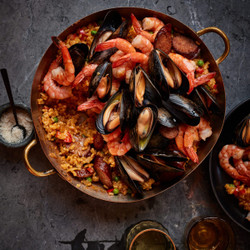In a 13-inch paella pan, large enameled cast-iron pan (like a Le Creuset), or a large skillet, heat 2 tablespoons of the oil over medium heat. Cook the sliced chorizo, flipping once, until lightly browned and some of the fat has rendered, about 3 minutes. Using a slotted spoon, transfer the browned chorizo to a plate and set aside. Add the onion and bell pepper to the pan and cook, stirring frequently, until softened, about 5 minutes. Add the garlic and cook 1 minute more. Stir in the tomato paste.
Add the rice and cook, stirring constantly, until coated with the vegetable mixture, about 2 minutes. Add the broth, clam juice, saffron, bay leaf, ¾ teaspoon salt and ¼ teaspoon pepper; bring to a boil. Cover and simmer over low heat, without stirring, until the rice is cooked and most of the liquid is absorbed, about 15 minutes. Discard the bay leaf. Stir in the peas, then the chorizo (along with any accumulated juices) and thyme; taste and adjust seasoning, if necessary. Remove the pan from the heat and cover.
In a separate large skillet, heat 2 tablespoons of the oil over medium heat until shimmering. Add the shrimp and sprinkle with ¼ teaspoon salt and a few grinds of pepper; cook, turning once, until the shrimp are pink and cooked through, about 3 minutes. Add the shrimp to the paella and cover to keep warm.
In the same skillet that you cooked the shrimp (no need to rinse it first), bring the wine to a boil over medium heat. Add the mussels and cover with a lid; cook, shaking the skillet occasionally, until the mussels open, 2 to 4 minutes. Pour the mussels and their cooking liquid over the paella.
Drizzle the remaining 1 tablespoon of oil over the paella and serve.
Note: Smoked chorizo is usually located near the hot dogs and bacon in the supermarket. It is already fully cooked, and it is not necessary to remove the casings.
Note: Bomba or Spanish paella rice, a short-grain rice prized for its ability to absorb three times its volume in broth (rather than the normal two times) while still remaining firm, can be found in many grocery stores or you can order it online.
Note: Saffron is harvested by hand, making it the most expensive spice in the world. Usually, it is sold in small quantities, and you only need a pinch. Saffron threads should be crushed before they are added to recipes to release their flavor. Simply use your thumb and forefinger to crush the threads into fine pieces. Be sure to use only the amount that the recipe calls for; too much saffron can give food a medicinal taste. Store any leftover saffron for up to 6 months wrapped in foil and placed in an airtight container in a cool, dark place.
Note: When you purchase mussels, they're still alive. After bringing them home from the store, they will stay fresh in the refrigerator for several days. Because they're alive, avoid storing them in an airtight container. Instead, place them in a bowl covered with a wet paper towel. To clean mussels prior to cooking, put them in a colander and run them under cold running water. Use your hands or a scrubbing brush to remove any sand or remaining debris. If beards (the little tuft of fibers the mussel uses to connect to rocks or pilings) are present, cut or scrape them off with a paring knife, or use your fingers to pull them sharply down toward the hinged point of the shells. The mussels should be tightly closed. If you see a mussel that is open, tap it gently against the counter; in a live mussel, this will trigger a reaction to close its shell. If the mussel doesn't slowly close, it has died and should be discarded. Discard any mussels with cracked shells as well.
